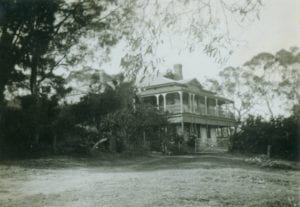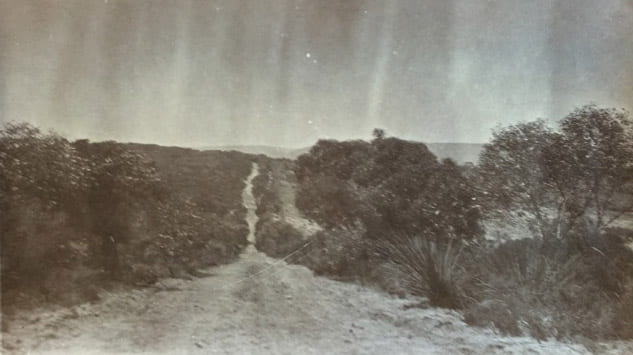Considering the literary archive: William Gosse Hay
Dr Rachael Weaver
School of Culture and Communication, University of Melbourne

I first became interested in the Australian writer William Hay ten years ago, when Ken Gelder and I re-published Hay’s 1921 story, ‘An Australian Rip Van Winkle,’ in our Anthology of Colonial Australian Gothic Fiction (2007). The tale is a delightfully strange one, about a stockman named Jake, a romantic figure who resembles the writer R. L. Stevenson; only he is ‘slightly more melancholy.’[1] It begins with a meditation on the idea of the ‘nowhere road’ – the kind of mysterious sandy white track that winds its way into the Australian bush and seems to promise all kinds of imaginative destinations. Hay’s quaint story was published a little late in the day to be considered strictly colonial, but something about it seemed to belong to the nineteenth century. Like much of Hay’s writing, it has qualities that are anachronistic and modern at the same time.
Hay was born into a prominent Adelaide family of successful Scottish settlers in 1875 and educated at Melbourne Grammar School before attending Trinity College, Cambridge, from 1895. His first novel, Stifled Laughter, was published in England in 1901, just before he returned to South Australia to marry Mary Williams. They moved into the grand ‘Tower House’ at Beaumont where they raised three boys, before moving to isolated ‘Nangawooka’ at Victor Harbour. Independently wealthy and naturally reclusive, Hay shut himself away and devoted his life to writing, eventually publishing six novels and a collection of stories. He collapsed and died after fighting a bushfire in 1945.

Hay’s novels are all set in Australia, exploring experiences of the convict system in NSW and Tasmania during the 1830s and 1840s. Despite their Australian focus, however, they received little local success. According to Hay’s biographer Fayette Gosse, his works were viewed as somehow ‘out of touch’ with Australian national feeling.[2] After he died Hay’s writing was critically re-evaluated but opinions were sharply divided. Some writers and scholars such as R G Howarth, Miles Franklin and J H M Abbott saw Hay as a kind of overlooked genius and described his best-known novel, The Escape of the Notorious Sir William Heans, as a masterpiece. But others, including critics John Barnes and Frederick Macartney, dismissed his writing as portentous and hollow. Even those invested in recuperating Hay’s career – such as his biographer Fayette Gosse, and would-be biographer Ian Muecke[3] – agreed that Hay had no real investment in achieving popular literary success. In any case, these debates soon faded away and Hay was, again, all but forgotten.
Last year I was fortunate to receive a Hugh Williamson Foundation Fellowship through the University of Melbourne Archives. This gave me the opportunity to look more closely at Hay’s legacy by examining his literary papers. Comprised of 26 boxes and two volumes, the collection contains all the everyday minutiae of this writer’s (privileged) private life (including personal diaries, photographs, real estate papers, legal documents, bankbooks, chequebooks, notebooks, and so on) alongside a lifetime of literary correspondence with his London publishers T Fisher Unwin and Stanley Unwin, his agent Robert Sommerville, his royalty statements, reader’s reports, manuscripts and revisions and much more. One of the most striking things I found when examining the collection was that, far from lacking aspirations for recognition, Hay craved literary acclaim, and he worked tirelessly towards achieving this. Tracing the material evidence of his efforts through the archive – and the residues of the failure with which these were often met – has allowed me to explore Hay’s literary career from the ‘inside’, to understand more about his exclusion from the Australian literary canon, and to think more generally about the forces influencing canonicity in the first half of the twentieth century.

Turning over this kind of biographical detail remains an important strategy in archival research – especially when exploring the legacies of little-known authors such as Hay. But this opportunity to examine his papers has also led me to engage with a more recent focus on the ‘archive-as-subject’ as Ann Laura Stoler puts it in her book, Along the Archival Grain.[4] Thinking about the materiality of the literary archive has become fundamental to what Maryanne Dever, Sally Newman and Ann Vickery identify as ‘a new critical turn’ in the humanities, which is leading us to reconsider ‘how we do things with a fragment, a word, a memory, a draft.’[5] In her examinations of the papers of Australian writer Eve Langley, for example, Dever has advocated a new ‘sensitivity to the materiality and expressive potential of paper.’[6]
Considering the literary archive as a series of interconnected objects – each with their own unique physicality quite apart from any textual meanings that they might offer up – is also a useful way of approaching the Hay archive. It helps us to reconsider the status of documents as evidence and acknowledge the many moments when an archive can disrupt our attempts at reading it. One vivid example of this is a photograph amongst Hay’s papers that returns us to the seductive idea of the ‘nowhere road’ in ‘An Australian Rip Van Winkle.’ It shows precisely one of those ‘curious survivals to be seen as you thread the wild ranges’[7] – an evocative image of uninhabited bushland spreading out on either side of a winding track. At first glance it seems to illustrate the story – or even provide the source of its inspiration – calling it up and capturing it. But who took it? Where? When – before or after Hay had written the story? At the same time that such objects seem particularly laden with meaning, they highlight the ways our own priorities and investments shape our readings of an archive – and remind us of what is intangible and unreachable there.

[1] William Hay, ‘An Australian Rip Van Winkle,’ in An Australian Rip Van Winkle and Other Pieces, Being a Sketch-book after the Style of Washington Irving. London: George Allen & Unwin, 1921. 8.
[2] Fayette Gosse, William Gosse Hay, Sydney: Lansdowne Press, 1965. 5.
[3] Muecke wrote a number of essays and a master’s thesis on Hay but was unable to carry out his intention of writing his biography. See I D Muecke, ‘William Hay and History: A Comment on Aims, Sources, and Method,’ Australian Literary Studies, 2.2 (1965): 117-137.
[4] Ann Laura Stoler, Along the Archival Grain: Epistemic Anxieties and Colonial Common Sense, New Jersey: Princeton University Press, 2009. 44.
[5] Maryanne Dever, Sally Newman and Anne Vickery, The Intimate Archive: Journey’s Through Private Papers, Canberra: National Library of Australia, p.1.
[6] Maryanne Dever, ‘Photographs and Manuscripts: Working with the Archive,’ Archives and Manuscripts, 42.3 (2014): 285.
[7] Hay, ‘An Australian Rip Van Winkle.’ 7.
Came here after reading of Hay in Geoffrey Duttons – “The Australian Collection” Australia’s Greatest Books. Well worth a read! ML